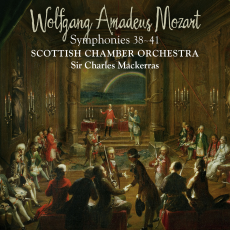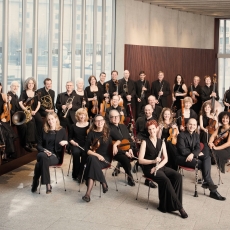Mozart Symphonies - SCO & Sir Charles Mackerras - 6moons.com
There are hundreds of recordings of Mozart's last four symphonies ranging from the sublime to the forgettable, a few even hitting the dreadful mark as far as I am concerned. Yet Sir Charles Mackerras and his Scottish Chamber Orchestra deemed it necessary to add another one to the catalog.
And darn right they were!
I always dread reviewing new recordings of the great classics and Mozart's late symphonies are no exception. What can possibly be said that has not been written already? What can a conductor unearth that we have not heard before? How far off the score do they need to wander to get our attention when Gardiner, Davis, Bohm, Krips and Beecham have given us such a rich legacy of interpretations?
The fact that the most enlightening answer in a long time comes from the 84-year old Mackerras and his not quite period, not quite modern orchestra is revealing in itself-perhaps it takes maturity and balance few have reached-but how they achieve it is the key to maybe a new era of interpretation. You'll read often enough that so and so has married modern and period interpretations techniques to great effect. Routinely the result is a hybrid that does not know where it belongs. The first successful attempt I heard is Paavo Järvi's recording of Beethoven's symphonies with Bremen. I find that Mackerras achieves the perfect blend better still.
The violins used by the SCO are modern instruments for tone and body but played without vibrato as is customary for the period crowds. The brass instruments are period horns and trumpets without valves for brassiness and acidity that contrasts against the full-bodied strings. Mackerras also favors the modern clarinet for its tonal color and delicacy over the oboe when both versions of the score exist (Symphony N°. 39 & 40 especially).
Sir Charles' reading on the symphony is both lithe and spirited without unnecessary weight or sweetness. But it is also dense and powerful sans harmonic thinning and excess harshness as can all too often be the case in radical period recordings. His artistic vision is superbly supported by Linn's recording crew. It is rare that one so easily perceives how the recording and mastering have been thought through to reinforce the conductor's intentions. The strings are superb and lush but don't sound like one big blob. They're finely articulated and defined yet in the 41st Symphony when Mozart uses muted strings for a completely novel effect, the recording conveys the restrain and hushed sounds better than any I have heard so far.
The trumpets and horns are recorded quite closely to emphasize brassiness and dynamics, a bit of a special effect that is kept in control to add just enough spice now and then to get our attention without intruding with the composition. The tympani also are more present than typical for most of Mozart's recording but here again the balance reached is one of accentuation without overwhelming the orchestra.
The end result throughout the four symphonies is a palette of instrumental colors that is extremely rich and diverse, and Mackerras uses it in a fashion that perpetually sheds new light on the music without ever sounding out of place. Rhythm and tempi are lively but never pressed, each musical phrase is easy to follow and identify yet Mackerras achieves this without tearing the fabric of the symphonies apart as is too common nowadays.
The notion for this review was not a blow-by-blow account of the four symphonies but to stress that regardless of whether you already own four sets of them or are contemplating acquiring your first, Sir Charles Mackerras' vision with the SCO is one of the very finest of the modern era - one that will move you emotionally and at the same time reward with insights that none of the others provides. The fact that the superb recording quality supports the artistic performance so perfectly makes this set a must own and a Blue Moon Award without any reserve.

